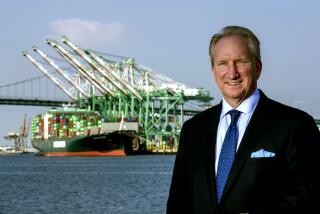Nassco Gets Contract to Fix Valdez’s Hull
- Share via
The Exxon Valdez, the oil tanker that ran aground off Alaska in March, causing the biggest oil spill in U.S. history, will be towed to San Diego next month for extensive repairs to its hull, Exxon officials said Monday.
The $25-million repair contract was announced by Exxon Shipping Co. President Frank J. Iarossi at a press conference at the National Steel & Shipbuilding Co. yard, where the repairs will be done and where the Valdez was built in 1986.
300 New Jobs to Be Created
Nassco President Richard Vortmann said the job will take about nine months and create 300 jobs.
Nassco workers are expected to repair an area 700 feet long and 100 feet wide, Iarossi said, which will require 3,000 tons of steel, about 10% of the ship’s total steel weight.
The ship’s dimensions were given as 987 feet by 166 feet.
The extent of the damage was recorded on videotape, which Exxon officials played on two closed- circuit televisions for reporters. Iarossi said a reef penetrated the hull as much as 18 feet in some areas. The ship’s depth was listed as 88 feet, and Iarossi said one area had a hole about 20 feet by 15 feet, “large enough to drive a trailer truck through.”
Acknowledging the environmental damage caused when the ship spilled 11 million gallons of oil after striking the reef--polluting about 730 miles of shoreline in pristine Prince William Sound--Iarossi went to unusual lengths to offer assurances that the Valdez is now “environmentally safe.”
Iarossi began the press conference by saying: “We at Exxon are truly sorry for the circumstances that led to today’s announcement.”
He said both the outside and inside of the ship have been cleaned and all remaining oil removed from the tanks, clearing the way for the ship to be towed to Nassco.
“In the past two months, we have been very active in clearing the oil residue from the tanks and exterior of the vessel,” said Iarossi, adding that the Coast Guard has inspected the ship and certified that there is no oil in the tanks. “Believe me, the last thing we want is more embarrassment or environmental impact from this vessel.”
Petty Officer Bill Ball, a Coast Guard spokesman in Valdez, said the ship’s tanks “are fairly clean” and added that Coast Guard officials are reviewing Exxon’s request for a permit to tow the vessel to San Diego.
Towing Permit Still Lacking
“We have not approved a permit for the vessel to proceed just yet,” Ball said. “We’re concerned that there is a safe transit with no chance for pollution.”
Company officials said they expect to get towing approval later this month, and it will take four tugs about 20 days to tow the Valdez 2,500 miles. The tugs will follow a course that will keep the Valdez at least 100 miles offshore, Iarossi said. The Valdez will not fire its engines during the trip.
Oregon Port Was First Choice
Portland, Ore., was Exxon’s first choice for a repair site. But company officials backed away in early April, when Oregon Gov. Neil E. Goldschmidt and managers of the Port of Portland expressed concern that the Valdez would still be leaking oil when it arrived.
Iarossi insisted Monday that the reluctance shown by Goldschmidt and Portland port officials to have the repairs done there played no part in awarding the contract to Nassco.
Iarossi said the Valdez will carry about 7.3 million gallons of seawater for ballast during the trip and contain 7 gallons of oil residue, or about 1 part of oil per million parts of water. In fact, Iarossi said, the inside of the tanks is so clean that an abundance of sea life, including fish, has sprung up.
However, Jay Powell of the San Diego-based Environmental Health Coalition, said his group is not convinced of the Valdez’s environmental safety.
Safety Questions Raised
“It begs the question why they are not going into Portland, when certain conditions were attached. Are those same conditions being attached here?” Powell asked.
San Diego Unified Port District officials could not be reached for comment late Monday afternoon.
Federal pollution laws allow the discharge of oil pollutants equivalent to 10 parts per million, Iarossi said.
“We’re going to go to extreme lengths to see that no water (from the ballast tanks) is discharged into San Diego Harbor,” he said, adding that water from the Valdez will be pumped into other Exxon ships and taken away when the vessel is docked.
Nassco, a shipbuilding institution in San Diego for 83 years, became employee-owned earlier this year. The Valdez contract came “at a very propitious time for us,” said Vortmann, its president.
The Valdez and its sister ship, the Exxon Long Beach, were the last two oil tankers built in the United States, and both were built at Nassco.
New Name Considered
Iarossi said Exxon officials are considering renaming the Valdez when the repairs are finished. He said company officials “are concerned about the feelings of the crew” assigned to a ship that has been linked to a drunken captain and an oil spill that is still making news, almost three months after it happened.
Joseph Hazelwood, 42, who was captain of the Valdez, has been charged with being drunk at the time of the accident and is facing criminal charges in the massive spill.
More to Read
Sign up for Essential California
The most important California stories and recommendations in your inbox every morning.
You may occasionally receive promotional content from the Los Angeles Times.










